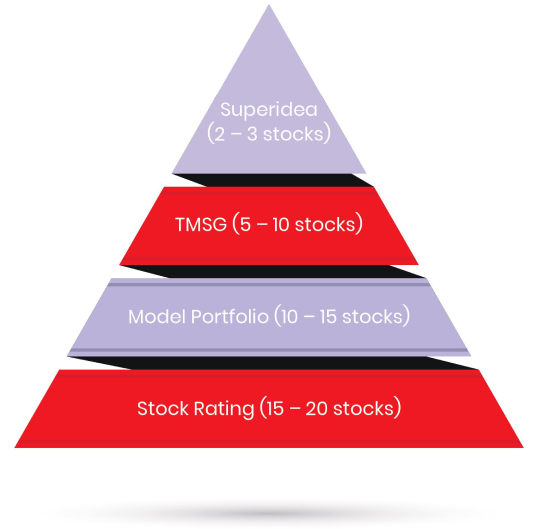Page
/ 5Investment Process – the Nippon Way
In the final edition of the Nippon Way, we provide you a glimpse of Analyst Output System – on how the research of Analysts flows to the Portfolio Managers, for better decision-making and subsequent construction of portfolios. You may recollect that in the previous editions, we had explained to you the importance of having Sector Limits, Active Share thresholds and Style Diversification in portfolio construction to possibly achieve relatively consistent returns. We had also explained the process of assigning Risk Rating to stocks and using that to mitigate portfolio risks.

Part 5: Analyst Output System
At Nippon India Mutual Fund, we have one of the largest investment teams in the industry. We lay extensive emphasis on in-house research – support systems and processes have been designed to facilitate the same. Given the large team, we have a fairly-large span of coverage – we cover nearly 550 stocks across large, mid and small cap universe. The teams carry out proprietary research including personal visits / engagements with companies they research, in addition to perusing third party research materials. The overall Fund Management philosophy is to buy companies having growth potential, available at reasonable prices (GARP – Growth at Reasonable Price), including taking significant stakes in companies where we have high conviction and holding them for a reasonably long term. Internally-built Knowledge Management System (KMS), which is a repository of extensive data pertaining to the companies under research and alignment of analyst KPIs (Key Performance Imperatives) to the quality of their output aid fund management.
With a view to have sharp focus on research, we have divided the team of analysts into two. One team to research the large & mid cap space, and the other to exclusively focus on the small cap segment. This is to align the different research requirements of these two segments with the actual work. We have also reduced the span of each analyst. From the earlier times when each Analyst was tracking about 70 stocks each, they now track only 40 stocks each. This, we believe, will increase their focus and improve the quality of output.
All the Analysts express their assessment of various stocks quantitatively. Out of the 40 stocks they track, typically they would give a buy rating for about 15-20 stocks, which is their first level of conviction. Out of this list, they maintain a model portfolio of 10-15 stocks. The model portfolio is benchmark-related where analysts will have to express their conviction through overweight / underweight positions relative to index weights.. While Model Portfolio is relative to indices, Analysts also run 5-10 absolute stock ideas in the Bloomberg TMSG (Trade Messaging) platform, which is their high-conviction ideas.
Further, each analyst comes out with up to 3 Superideas, in turn, to be presented to Fund Managers for their assessment and possible inclusion in the funds.
PICTORAL REPRESENTATION OF THE ANALYST OUTPUT SYSTEM

The output of the model portfolio, TMSG and superideas have a direct linkage with the KPIs of the Analysts, making the entire research process objective and measurable. Stronger the research, the better the flow of research to the portfolio managers (through the Analyst Output System), the better the potential of end-results.
THE NIPPON WAY
To summarize, (i) sharper focus on research by reducing the span of analysts, (ii) quantitative expression of different levels of conviction, (iii) linkage of KPIs with the quality of output and (iv) Risk Rating of Securities and (v) self-imposed framework called Fund Casing where various parameters like Sector Deviation, Stock Concentration Limits, Active Share Limits, etc. have been defined help us in our endeavour to generate returns within a risk-mitigated framework, the Nippon Way!

Disclaimer: The information herein above is meant only for general reading purposes and the views being expressed only constitute opinions and therefore cannot be considered as guidelines, recommendations or as a professional guide for the readers. The document has been prepared on the basis of publicly available information, internally developed data and other sources believed to be reliable. The sponsor, the Investment Manager, the Trustee or any of their directors, employees, associates or representatives (“entities & their associates”) do not assume any responsibility for, or warrant the accuracy, completeness, adequacy and reliability of such information. Recipients of this information are advised to rely on their own analysis, interpretations & investigations. Readers are also advised to seek independent professional advice in order to arrive at an informed investment decision. Entities & their associates including persons involved in the preparation or issuance of this material shall not be liable in any way for any direct, indirect, special, incidental, consequential, punitive or exemplary damages, including on account of lost profits arising from the information contained in this material. Recipient alone shall be fully responsible for any decision taken on the basis of this document.
